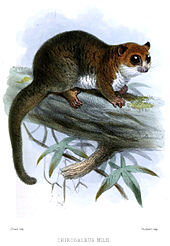- Greater dwarf lemur
-
Greater dwarf lemur[1] Conservation status Scientific classification Kingdom: Animalia Phylum: Chordata Class: Mammalia Order: Primates Family: Cheirogaleidae Genus: Cheirogaleus Species: C. major Binomial name Cheirogaleus major
É. Geoffroy, 1812
Greater dwarf lemur range Synonyms - commersonii Wolf, 1822
- griseus Lesson, 1840
- milii É. Geoffroy, 1828
- typicus A. Smith, 1833
- typus F. Cuvier, 1842
The greater dwarf lemur (Cheirogaleus major), or the Geoffroy's dwarf lemur, is a lemur that is widely distributed over the primary and secondary forests near the eastern coast of Madagascar.
Its fur is grey or reddish brown, and there are dark circles around the eyes. At the end of the wet season the tail will become somewhat swollen with fat.
It is preyed upon by the ring-tailed mongoose (Galidia elegans) and the Madagascar buzzard (Buteo brachypterus),[3] and it is thought probably by the Fossa (Cryptoprocta ferox) as well, since the latter preys on other lemurs.[4]
Taxonomy
Between 2000 and 2009, populations of dwarf lemur around Tamatave, Tampira, Mahambo, Ancaya, Ambodivoangy, and Fesi Malendo were known as a separate species, the greater iron-gray dwarf lemur (Cheirogaleus ravus). It was described as having a pelage coloration that is iron-gray with brownish tones, a vague dorsal stripe, white feet, a tail with a white tip, and dark ears that are either naked or sparsely covered with hair.[citation needed] However, in 2009, Groeneveld et al demonstrated genetically that Cheirogaleus ravus was a synonym of Cheirogaleus major, so the greater iron-gray dwarf lemur is no longer recognized as a species.[5][6]
References
- ^ Groves, C. (2005). Wilson, D. E., & Reeder, D. M, eds. ed. Mammal Species of the World (3rd ed.). Baltimore: Johns Hopkins University Press. pp. 112. OCLC 62265494. ISBN 0-801-88221-4. http://www.bucknell.edu/msw3/browse.asp?id=12100011.
- ^ Andrainarivo, C., Andriaholinirina, V. N., Feistner, A., Felix, T., Ganzhorn, J., Garbutt, N., Golden, C., Konstant, B., Louis Jr., E., Meyers, D., Mittermeier, R. A., Perieras, A., Princee, F., Rabarivola, J. C., Rakotosamimanana, B., Rasamimanana, H., Ratsimbazafy, J., Raveloarinoro, G., Razafimanantsoa, A., Rumpler, Y., Schwitzer, C., Thalmann, U., Wilmé, L. & Wright, P. (2008). Cheirogaleus major. In: IUCN 2008. IUCN Red List of Threatened Species. Downloaded on 1 January 2009.
- ^ Goodman, S. M., O'Conner, S., Langrand, O. (1993). "A review of predation on lemurs: Implications for the evolution of social behavior in small, nocturnal primates". Lemur Social Systems and their Ecological Basis: 51–66.
- ^ Wright, P. C., et al. (1997). "Predation on Milne Edwards Sifaka (Propithecus diadema edwardsi) by the Fossa (Cryptoprocta ferox) in the rainforest of southeastern Madagascar". Folia Primatologica 68 (1): 34–43. doi:10.1159/000157230.
- ^ Mittermeier, R.A.; Louis, E.E.; Richardson, M.; Schwitzer, C.; Langrand, O.; Rylands, A.B.; Hawkins, F.; Rajaobelina, S. et al. (2010). Lemurs of Madagascar. Illustrated by S.D. Nash (3rd ed.). Conservation International. p. 183. ISBN 978-1-934151-23-5.
- ^ Groeneveld, L.F.; Weisrock, D.W.; Rasoloarison, R.M.; Yoder, A.D.; Kappeler, P.M. (2009). "Species delimitation in lemurs: multiple genetic loci reveal low levels of species diversity in the genus Cheirogaleus" (PDF). BMC Evolutionary Biology 9 (30): 30. doi:10.1186/1471-2148-9-30. PMC 2652444. PMID 19193227. http://www.biomedcentral.com/content/pdf/1471-2148-9-30.pdf.

This lemur-related article is a stub. You can help Wikipedia by expanding it.



